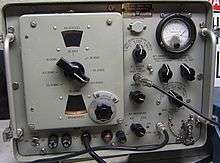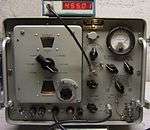AN/URM-25D signal generator
The AN/URM-25 signal generator was an electronic vacuum-tube radio-frequency (RF) signal generator used during the 1950s and 1960s by the U.S. Military to test electronic equipment.
 URM-25 signal generator c. 1955 | |
| Uses | Aligning radio equipment |
|---|---|
| Manufacturer | Various, commissioned by U.S. military |
| Model | 25D |
History
The AN/URM-25 was part of a series of vacuum tube-based signal generators built for the U.S. military in the early Cold War-era.
Today they are collected and used by vintage amateur radio and antique radio enthusiasts who say they provide reasonably high accuracy and stability for a low cost, with build quality reflecting tough military construction requirements and standards.[1]
Specifications

Frequency output ranges from 10 kHz to 50 MHz with amplitude modulation selectable at 400 and 1,000 Hz. RF level from 0.1 microvolts to 100 millivolts or 2 volts is available depending upon termination load. Output impedance is 50,500 ohms.
Carrier signal generation is performed by a 6AH6 tube with an additional 6AH6 buffer stage followed by a 6AG7 output amplifier. Amplitude modulation at 400 and 1,000 Hz is provided by a 5814A (military 12AU7) oscillator. URM-25x models also contain an internal VTVM (vacuum tube voltmeter) and crystal calibration.
The carrier frequency can be set by interpolation using the graduated dial. Additionally, the URM-25's have a BNC connector for constant 200 mV output that can be connected to a frequency meter to display frequency accurately. A sufficient warm-up period is required to ensure the best stability at higher frequencies.
The cabinet cover includes accessories such as an impedance adapter, fixed attenuator and antenna simulator. Additional accessory kit MK-288 includes adapters and more dummy loads.[2][3]
Models and differences
"URM" indicates general utility, radio, and maintenance and test assembly. The URM-25 units were released in several series from 25A through 25J; some differ substantially in both circuitry and configuration. It is common to find units having differing identification tags; i.e. front face tag may differ from the cabinet tag. Additionally, some units have additional minor circuitry that do not show up on the schematic.
Overhauling
Some present-day electronic hobbyists say the URM-25 series is a good cost-effective choice to use for tuning radio equipment; but overhauling can be tricky and time-consuming. Many say that the model F is easier to work on than the model D, which is in relatively plentiful supply.[1]
References
- "Archived copy" (PDF). Archived from the original (PDF) on 2008-12-01. Retrieved 2009-01-04.CS1 maint: archived copy as title (link) R-390a.net, URM-25x discussions
- R.F. Signal Generator Set AN/URM-25D, by United States Dept. of the Army, Dept. of the Army, United States Air Force, United States, Air Force. Published by Departments of the Army and Air Force, 1993
- TM 11-6625-278-20P, DEPARTMENT OF THE ARMY TECHNICAL MANUAL ORGANIZATIONAL MAINTENANCE REPAIR PARTS AND SPECIAL TOOL LISTS, SIGNAL GENERATOR SET AN/URM-25D
External links
- Example Overhaul: http://www.chuckg.com/urm25d_repairs.htm
- Example Overhaul-capacitors, resistor replacement: http://www.wikihow.com/Restore-an-Urm-25D-Signal-Generator